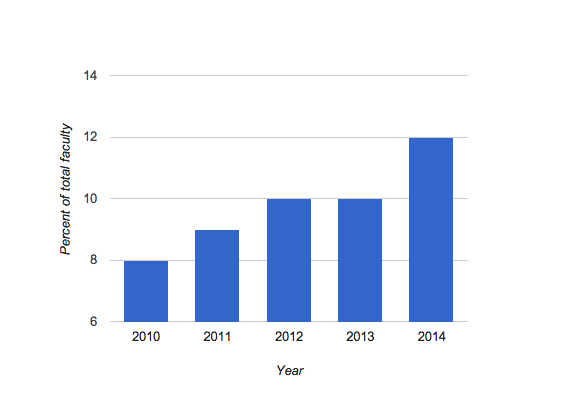College Struggles to Hire Minority Faculty
Students at college campuses across the nation are calling for more faculty of color to be hired by their institutions, and students at Dickinson have expressed that same desire during recent demonstrations and dialogue events about race and inclusivity on campus.
However, according to Neil Weissman, provost and dean of the college, “the job market for faculty of color is highly competitive.” The Faculty Data page on Dickinson’s website reports the percentage of faculty of color has increased from 8 percent in 2010 but remained at 12 percent in 2014.
Weissman said that diversifying the faculty is not an immediate process because the college can only recruit new professors when positions become vacant. Creating new faculty positions can add up to $100,000 to the college’s annual operating budget.
Anthony Pires, chair of the Faculty Personnel Committee, which advises Weissman and President Roseman on hiring faculty and awarding tenure, said that the difficulty of identifying and recruiting minority candidates is another obstacle to diversifying the faculty.
“While it is easy for candidates to find information about specific jobs [through job ads in industry publications], the reverse is not true,” Pires said. “It is not so easy for colleges to find information about available candidates until they apply.”
At schools such as the University of Missouri, student activists have demanded that administrations implement hiring quotas for faculty of color. According to Weissman, however, “restricting consideration for a faculty position to candidates of color or establishing hiring quotas based on race is illegal.”
Another limitation to hiring minority faculty is the paucity of black and minority Ph.D. candidates. According to a Dec. 4 article in the Chronicle of Higher Education, “a total of 2,649 black students earned doctorates [in 2014], representing less than five percent of the 54,070 doctorates awarded [nationwide]… [black students] accounted for 3 percent of Ph.Ds. in the humanities, almost 11 percent of doctorates in education, [and 1.7 percent of degrees in engineering.]”
The limited availability of eligible minority candidates makes the process of hiring them especially competitive. Weissman said that the college is attempting to overcome these barriers by “helping departments build inclusive pools of candidates, emphasizing inclusivity as a goal and urging flexibility in candidates’ fields of expertise.”
To that end, Weissman reports that the college has “instituted a workshop for hiring departments on building diverse candidate pools and combating bias, and we have joined with other liberal arts colleges to build relationships with graduate schools producing relatively large cohorts of graduates of color.”
Dickinson has joined with the Consortium for Faculty Diversity, an association of liberal arts colleges “committed to strengthening the ethnic diversity of students and faculty members at liberal arts colleges,” according to its website. The consortium accepts applications for dissertation fellowships and post-doctoral fellowships from U.S. citizens who are members of underrepresented minority groups. The consortium’s member institutes then appoint applicants to fellowships based on local needs.
Dickinson’s membership with the consortium “has had some success in identifying and hiring faculty of color,” said Pires.
“Because Dickinson is in competition with other institutions for hiring faculty of color, there is an advantage to getting CFD [Consortium for Faculty Diversity] fellows on-campus very early in their careers.”
There are currently five tenure-track searches being worked on as well as another that will be due in the spring, according to Weissman. He said that all of these resources would be put to work to possibly affect change in the future hiring process of faculty of color.






